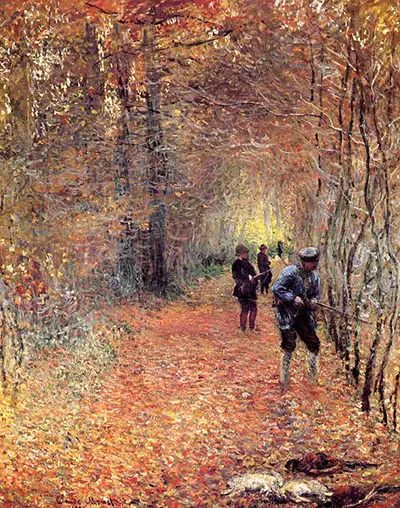The Shoot otherwise known as "the hunting" was done in 1876, at the time which Monet was struggling to build favor upon Impressionism.
Paintings such as the shoot were not finding favor in exhibitions at the time as they had disregarded most of the academic painting guidelines at the time. Like in many other Monet's impressionism works, light and color take a front row in the shoot, while images are less imploring. Similar can be found in his work with Haystacks, Rouen Cathedral and his famous Water Lilies.
This was unconventional of the painting techniques popular at the time. The shoot shows Monet's love for natural light as he tries to balance it with the contrast available in a forest setting.
The French artist Claude Monet was famous for his works and contribution to impressionism art. The shoot is part of his impressionism works which attracted a lot of attention. The technique involved trying to find a balance between contrast and lighting.
The Shoot's setting is a forest. It contains the images of three men holding guns seeming to be hunting. This aspect gives the painting the name "the hunting." As much as Monet paid attention to natural light and contrast in this painting, the images of these men are very imploring.
They seem keen and ready to pounce on anything that comes their way. It is an interesting setting explore, considering the lighting and contrast dimensions presented by a forest setting. The brown tree images blend well with Monet's use of light in the painting to create an aura of keenness just as presented by the images of the hunting men.
There are images of what seems to be a kill the hunting men have already made on the right bottom corner of the painting. This adds a notion of mastery to the painting. The painting, therefore, depicts a theme of keenness and mastery of a particular craft, which in this particular case is hunting.
In his endeavors to popularize impressionism at a time, it was frowned upon, Monet worked with several like-minded artists. The artists included; Pierre-Auguste Renoir, Camille Pissarro, and Alfred Sisley whom they together opened an exhibition for impressionism art.
Monet also drew inspiration from other renowned artists at the time and used some of their techniques in his works. Among the painters that Monet borrowed a leaf from are; Manet, Degas, and Caillebotte. These were painters of modern life, an aspect that Monet was trying to introduce through his impressionism works and advocacy.
Among the paintings that brought Claude Monet a lot of popularity are two paintings of his first wife Camille Doncieux. One called Woman with a Parasol and Camille or The Woman in the Green Dress. Camille also featured in quite a number of Monet's paintings such as Women in the Garden, and On the Bank of the Seine, Bennecourt.
Other notable paintings include the Saint-Lazare Train Station series in 1877 which consisted of 11 pieces. The canvas Monet used in this painting was so large, that he had to lower the bottom part of it into a trench so that he could paint the upper part. The painting depicted a locomotive arriving at one of the most famous train stations in Paris the Saint-Lazare Train Station series, amidst a cloud of smoke. Most of Monet's popular artwork was impressionism art.


